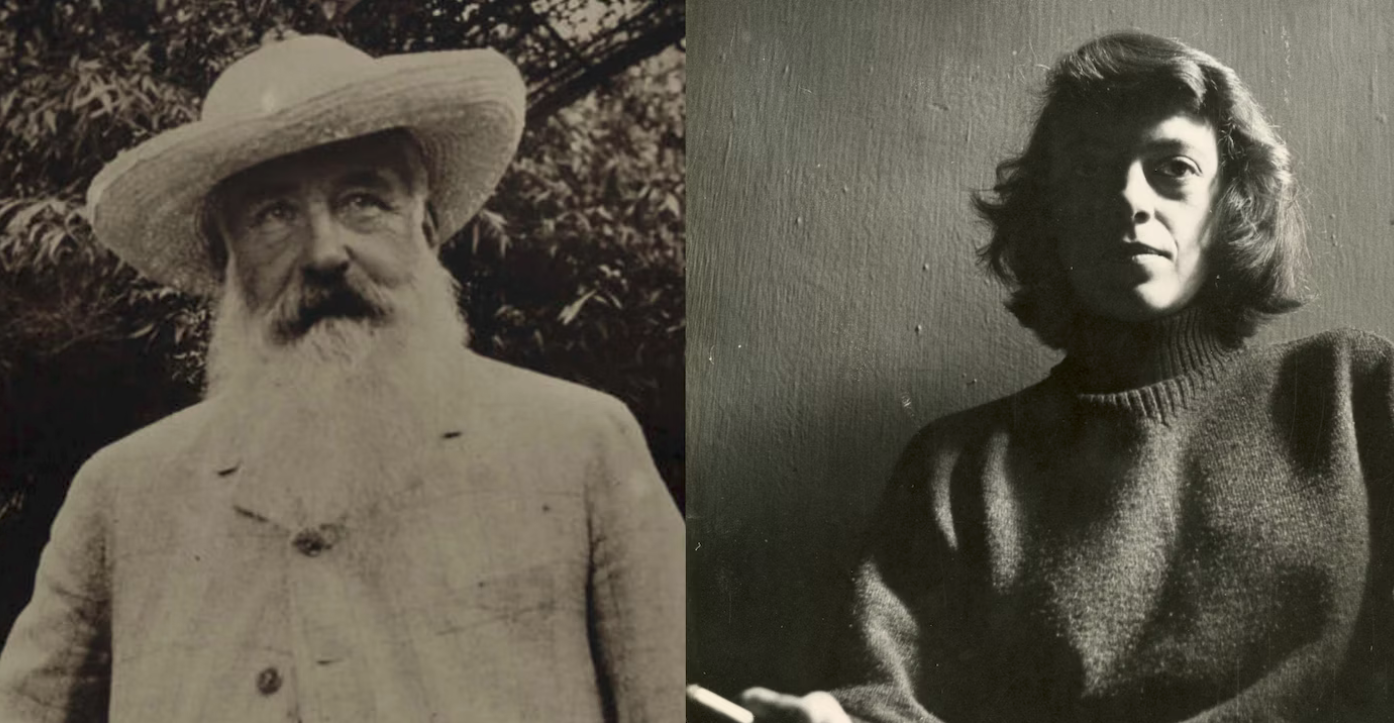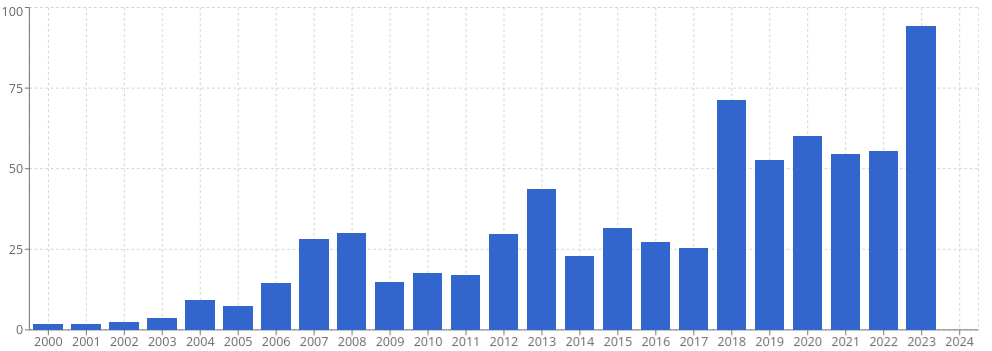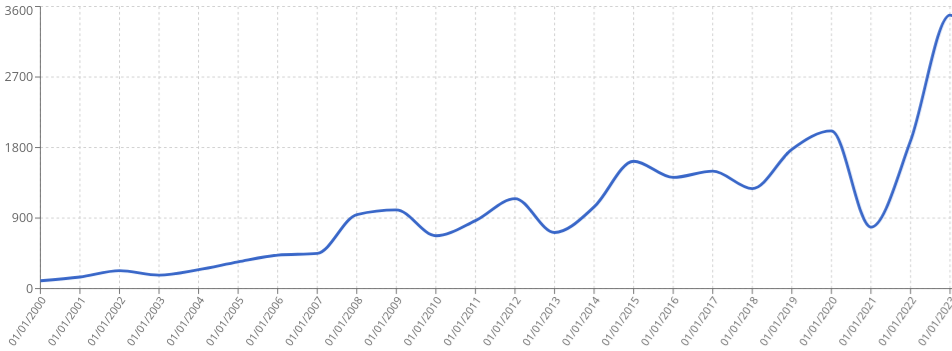Joan Mitchell: more than ever in demand
[12 Mar 2024]A poetry and nature enthusiast, Joan Mitchell was one of the first internationally recognized female artists in the middle of the last century, and her current success is particularly emblematic of the revaluation of women artists.
Born in the United States to a poet and an art-enthusiast doctor, Joan MITCHELL (1925-1992) hesitated for a while between painting and poetry. She ended up connecting the two by painting feelings in a manner that is both gestural and contemplative. The power of her work was superbly revealed two years ago alongside works by Claude Monet, as part of a Monet-Mitchell exhibition hosted by the Fondation Vuitton in Paris, in collaboration with the San Francisco Museum of Modern Art (SFMOMA) and the Baltimore Museum of Art (BMA).
The juxtaposition of these two giants of Modern and Contemporary painting recalled the importance of Monet’s work in the development of American art in the last century. Monet’s Water lilies were highly appreciated in 1950s America where the Abstract Expressionists saw them as prefiguring abstraction, and it was precisely at the very moment when Monet’s art was inspiring American creativity that Joan Mitchell became one of the central figures of the new New York scene and one of the rare female members of the very exclusive Club, founded by the artists of the New York school. Although the Club was the center of intellectual life in post-war New York, the work of its affiliates was too radical to respond to market trends and the general tastes of that time. But everything changed in 1951 when the artists of the Club organized their own exhibition – The Ninth Street Show – with the help of the then relatively unknown art dealer Leo Castelli. Works by Joan Mitchell were presented alongside paintings by Jackson Pollock and Willem de Kooning (among many others) in a founding exhibition that shaped the course of art history and contributed to the triumph of the American avant-garde. Joan Mitchell came out of the shadows at a time when women artists were struggling much more than men to be recognized: the initial meetings to organize the The Ninth Street Show discussed the risk of not being taken seriously by including women artists in the exhibition!

Claude Monet and Joan Mitchell
By taking the gamble of exhibiting the work of eleven women artists, the Ninth Street Show nevertheless went far beyond initial expectations, and some critics have suggested that it was a key moment in the transfer of the art world’s center from Paris to New York. After several New York exhibitions, notably at the Whitney Museum and the New Gallery, Mitchell chose to live in France where, in 1955, she met Jean Paul Riopelle, and they lived together until 1979. Living in France was also a way of strengthening the connection she felt with a country that shaped artists like Paul Cézanne and Vincent van Gogh, whose works had impressed her as a child during visits to the Art Institute of Chicago.
In 1968, Mitchell settled in a property in Vétheuil, close to Giverny where Claude Monet had lived from 1878 to 1881. This move brought her even closer to the universe inhabited by the Impressionist artist and Vétheuil saw the birth of her large polyptychs that capture the essence of nature and the lyricism of the landscape. It was here that she painted her emblematic abstract compositions, reminiscences of landscapes seen or felt, which she composed in her studio, favoring memory and imagination over visual inspiration. The gestural expressiveness of these paintings – which some have referred to as “surges” – was of course related to her first American abstract adventures, while resonating powerfully with a form of “abstract impressionism” (term coined by Elaine de Kooning), characteristic of the works made by Monet towards the end of his life, when his eyesight was fading.
One of the most sought-after women artists on the market
In France, Joan Mitchell collaborated with the Parisian gallerist Jean Fournier, a pioneer in the discovery of Abstract Expressionists in France. His energetic promotion of her work led to it being integrated into a number of important private and public collections, including that of the Pompidou Center. But her popularity was substantially stronger in the United States where Mitchell’s works were acquired by around thirty museums across the country as well as by major private collectors. It is therefore no surprise that the American auction market for her works is ten times larger (in volume) than in France and in 2023 it accounted for 93% of her annual auction turnover.
Mitchell’s turnover at auction (copyright Artprice.com)

Since 2018, when international gallerist David Zwirner took control of Mitchell’s estate, the international recognition and popularity of Joan Mitchell’s work has substantially increased, and so too has her market visibility. Just two weeks after David Zwirner’s official announcement of his gallery’s decision to represent Mitchell’s works, Christie’s sold her painting Blueberry in New York for $16.6 million against a high estimate of $7 million. Over the following years, her prices further inflated: her diptych La Grande Vallée VII (1983), acquired for $330,000 in 1989, was resold for $14.5 million (44 times higher) in 2020. In total, since 2018, 13 out of the 14 Mitchell works offered at auction have fetched auction results above the $10 million threshold, with the prices of her large diptychs multiplying five or six times in around ten years. According to Alexander Rotter, President of Christie’s Post-War and Contemporary Art Department in New York, this price acceleration constitutes a long overdue market adjustment. In 2023, Joan Mitchell’s work reached new auction milestones with two paintings each fetching over $27 million.
Joan Mitchell price index at auction (copyright Artprice.com)

Mitchell’s example is also very representative of a more general revaluation of other major 20th century female artists, an increasing number of whom are fetching top bracket prices. Ten years ago, Joan Mitchell was the only woman ranked among the world’s top 50 artists based on her annual sales turnover. Today, she shares this privilege with four other artists: Yayoi Kusama, Georgia O’Keefe, Louise Bourgeois and Cecily Brown. Mitchell often made fun of being a “lady painter”, but in 2023 she was the twelfth most sought-after artist on the global auction market, with a turnover of $112.6 million, higher than the turnovers of the American giants of abstract art, Mark Rothko and Cy Twombly. Indeed, exceeding the $100 million threshold in annual turnover also has symbolic importance, because, until now, this level of demand was always reserved for male artists, with the exception of the Japanese artist Yayoi KUSAMA.




 30.6
30.6
